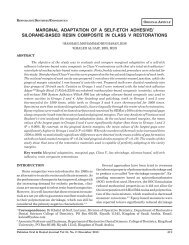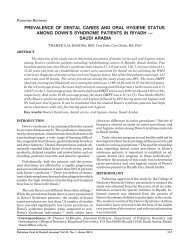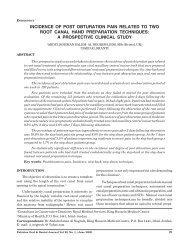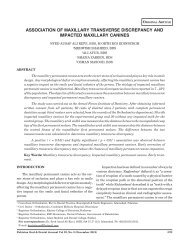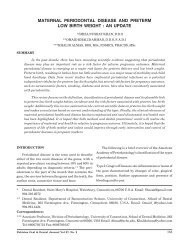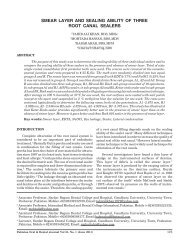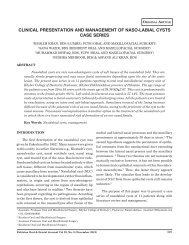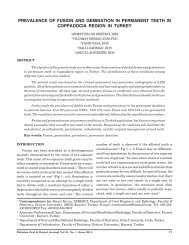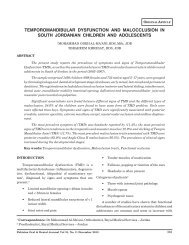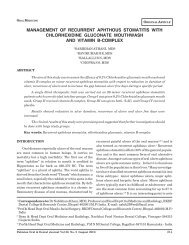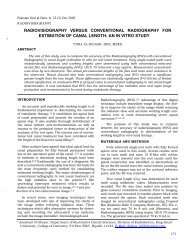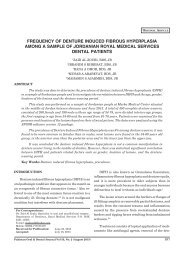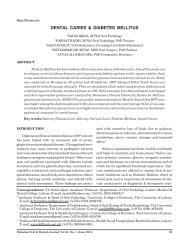zygomatic pseudojoint (jacob's disease) - Pakistan Oral and Dental ...
zygomatic pseudojoint (jacob's disease) - Pakistan Oral and Dental ...
zygomatic pseudojoint (jacob's disease) - Pakistan Oral and Dental ...
Create successful ePaper yourself
Turn your PDF publications into a flip-book with our unique Google optimized e-Paper software.
Jacob's <strong>disease</strong> of coronoid<br />
ORAL & MAXILLOFACIAL SURGERY<br />
OSTEOCHONDROMATOSIS AND THE CORONOID- ZYGOMATIC<br />
PSEUDOJOINT (JACOB’S DISEASE) AS AN UNUSUAL CAUSE OF<br />
MIDFACIAL ASYMMETRY AND JAW RESTRICTION<br />
ABSTRACT<br />
MERVYN M HOSEIN, FDS RCS (Eng), FDS RCSE (Edin), FDS RCSI (Ire)<br />
A young male presenting with a history of progressive midfacial symmetry <strong>and</strong> limitation of<br />
mouth opening was found to have a unilateral coronoid hyperplasia forming an osteochondromatous<br />
<strong>pseudojoint</strong> with the exp<strong>and</strong>ed <strong>zygomatic</strong> arch (Jacob’s <strong>disease</strong>). This paper reviews the differential<br />
diagnoses of problems, especially in developing countries, that can cause restricted mouth opening,<br />
highlighting problems with conventional radiography <strong>and</strong> the role of CT assessment in the diagnosis<br />
of this rare condition.<br />
Key Words: Jacob’s <strong>disease</strong>; <strong>pseudojoint</strong>; osteochondroma; coronoid enlargement; restricted opening;<br />
facial deformity.<br />
INTRODUCTION<br />
Jacob’s <strong>disease</strong> is an extremely rare condition<br />
characterized by osteochondroma caused coronoid hyperplasia<br />
<strong>and</strong> the formation of a <strong>pseudojoint</strong> between<br />
the hyperplastic coronoid <strong>and</strong> the inner aspect of the<br />
proportionally enlarged <strong>zygomatic</strong> arch. 1,2 It is reported<br />
most frequently in young patients with a mean<br />
age of 27 a male dominance <strong>and</strong> a predilection for the<br />
left side. 3 The large coronoid process exerts pressure<br />
that results in restricted jaw movements, mid-face<br />
deformity <strong>and</strong> possible malocclusion. Hypertrophy or<br />
fibrosis of the affected masticatory muscles may worsen<br />
the symptoms. While hyperplasia of the coronoid can<br />
occur bilaterally, in unilateral cases patients may<br />
present with facial asymmetry. Since this is a rare <strong>and</strong><br />
slowly progressive disorder that can mimic a wide<br />
range of problems including the common TMJ dysfunction<br />
<strong>and</strong> may not clearly be visible on conventional<br />
radiographs, an early diagnosis can be missed resulting<br />
in greater morbidity.<br />
Professor <strong>and</strong> Head of Dentistry Department<br />
V.P., Hamdard College of Medicine <strong>and</strong> Dentistry<br />
Hamdard University, ST-2 Block “L” North Nazimabad Karachi<br />
Tele: (021) 36648111; 36647356; 36647163<br />
Address for correspondence: 19 A, Block 7 & 8, KCHS Adj. Bagh e<br />
Bahar, Shaheed-e-Millat Road Karachi 74800, <strong>Pakistan</strong><br />
Tele: +92 21 34531697 Fax +92 21 34531325 mmh5617@gmail.com<br />
Received for Publication: July 4, 2013<br />
Accepted: July 11, 2013<br />
<strong>Pakistan</strong> <strong>Oral</strong> & <strong>Dental</strong> Journal Vol 33, No. 2 (August 2013)<br />
CASE REPORT<br />
A 15years old male presented with a history of<br />
painless left sided facial asymmetry <strong>and</strong> progressive<br />
limitation of mouth opening increasing over the past<br />
year A bony hard, non tender, asymmetric enlargement<br />
at the left <strong>zygomatic</strong> <strong>and</strong> mid-face region was<br />
obvious <strong>and</strong> the laterally flaring <strong>zygomatic</strong> arch curve<br />
was distinctly palpable. Fig.1 Mouth opening was<br />
22mm with left deviation. He had no significant medical<br />
history <strong>and</strong> neither he nor his parents recalled any<br />
specific early trauma to the site. He had no oral habits<br />
that could cause restricted opening. Other parameters<br />
were normal for his age. Intra-oral examination revealed<br />
no abnormality other than a more prominent<br />
left anterior ramus <strong>and</strong> the wider curve of the left arch<br />
in the upper buccal sulcus. There was no clear evidence<br />
of TMJ Dysfunction, one presumptive diagnosis.<br />
Due to superimposition of bone shadows in the<br />
region the panoramic radiograph (OPG) Fig. 2 was not<br />
very helpful. The occipito- mental radiograph showed<br />
a larger left <strong>zygomatic</strong> arch curve <strong>and</strong> either a considerably<br />
enlarged left coronoid or ossification in the<br />
attached temporalis tendon but was unclear about its<br />
direction of growth. Fig. 3 In both radiographs both<br />
condyles were normal <strong>and</strong> there was no other bone<br />
pathology. A tentative diagnosis of coronoid related<br />
extra-articular ankylosis was made.<br />
232
Jacob's <strong>disease</strong> of coronoid<br />
Axial <strong>and</strong> coronal computerized tomographic (CT)<br />
scans showed the joint like relationship of the enlarged<br />
coronoid against the medial cortex of the left zygoma<br />
with enlargement <strong>and</strong> remodeling of the bone <strong>and</strong><br />
arch. Fig. 4 (a <strong>and</strong> b)<br />
Fig 1:<br />
(a) Frontal <strong>and</strong> (b) superior views of patient<br />
showing left sided <strong>zygomatic</strong> enlargement.<br />
Fig 4:<br />
(a) axial <strong>and</strong> (b) coronal CT scan views showing<br />
the bulbous enlargement of the left coronoid<br />
<strong>and</strong> asymmetric expansion in the <strong>zygomatic</strong><br />
region to accommodate the <strong>pseudojoint</strong>.<br />
A soft tissue ‘capsule’ like arrangement can be<br />
seen enveloping the ‘joint’.<br />
Fig 2:<br />
OPG showing the enlarged left coronoid with<br />
possible bulbous tip (arrow)<br />
Fig 3:<br />
Occipito-mental radiograph showing the enlarged<br />
left coronoid process. Compare the size<br />
differences (arrowed).<br />
Fig 5:<br />
Resected left coronoid with laterally curved<br />
<strong>and</strong> smooth “articular” head. Note the remnants<br />
of the temporalis tendon attachment<br />
lower down the bone.<br />
<strong>Pakistan</strong> <strong>Oral</strong> & <strong>Dental</strong> Journal Vol 33, No. 2 (August 2013)<br />
233
Jacob's <strong>disease</strong> of coronoid<br />
On 6 July 2006 the left <strong>pseudojoint</strong> coronoid was<br />
‘disarticulated’ <strong>and</strong> removed intraorally through a<br />
superiorly extended ramus incision <strong>and</strong> dissecting<br />
through the enveloping muscles at the level of the<br />
<strong>zygomatic</strong> arch. The laterally flaring upper tip ended<br />
in a smooth, bulbous joint surface. Fig. 5 The wound<br />
was sutured over a drain tube left for 24 hours.<br />
Histopathology confirmed a fibrous tissue capped osteochondroma<br />
at the tip of the hyperplastic, curved,<br />
coronoid.<br />
Assisted by vigorous exercise, post operative trismus<br />
settled over the next few weeks. Mouth opening<br />
was 41 mm four months later. The parents were<br />
advised that in view of his youth the <strong>zygomatic</strong> enlargement<br />
would remodel over the next few years. Any<br />
residual asymmetry could be addressed then. His face<br />
had improved considerably over 18 months review.<br />
DISCUSSION<br />
Osteochondromas are among the most common<br />
benign tumors of the skeleton but are rarely found in<br />
the craniofacial bones. In this situation the majority<br />
have arisen as male predominant, unilateral or less<br />
frequently bilateral, growths in the coronoids or<br />
coronoid process or with occasional reports in other<br />
sites. 1,2,3,4 They most commonly come to attention as a<br />
restriction in opening, or occlusal disturbances or as a<br />
progressive facial deformity. 4,6,5<br />
Coronoid hyperplasia was originally described by<br />
von Langenbeck in 1853. The hyperplastic coronoid<br />
process can impinge against the <strong>zygomatic</strong> arch restricting<br />
jaw movements. 8 The formation of a<br />
<strong>pseudojoint</strong> between the enlarged coronoid process<br />
<strong>and</strong> the inner aspect of the <strong>zygomatic</strong> arch is an even<br />
rarer occurrence that was first described by anatomist<br />
Oscar Jacob in 1899. 1,2,9 The pathogenesis of the <strong>disease</strong><br />
is still not clear although numerous factors have<br />
been suggested. In addition to excessive temporalis<br />
muscle pull <strong>and</strong> chronic TM joint dysfunction, endocrine<br />
stimulation, trauma, genetic <strong>and</strong> familial predisposition<br />
are possible etiological factors. 2,3<br />
Apart from local, relatively transient, masticator<br />
inflammatory <strong>disease</strong> <strong>and</strong> the fairly common problems<br />
of TMJ dysfunction, 3 the differential diagnosis in<br />
<strong>Pakistan</strong> <strong>Oral</strong> & <strong>Dental</strong> Journal Vol 33, No. 2 (August 2013)<br />
patients with chronic restricted mouth opening includes<br />
muscle <strong>disease</strong>s, oro-pharyngeal neoplasms <strong>and</strong><br />
coronoid hypoplasia. 2 Rarely, post traumatic ankylosis<br />
can occur between the <strong>zygomatic</strong> arch <strong>and</strong> coronoid. 10<br />
In the Asian region this is not uncommon while <strong>Oral</strong><br />
Submucous Fibrosis (OSF), 11 <strong>and</strong> articular TMJ Ankylosis,<br />
12 are extremely important <strong>and</strong> fairly common<br />
causes of restricted mouth opening, especially in the<br />
younger age group. Also in this age group the painless<br />
slowly growing bony swelling <strong>and</strong> deformity may be an<br />
indicator of localized fibro-osseous <strong>disease</strong> which has a<br />
predilection for the maxilla / <strong>zygomatic</strong> region.<br />
Panoramic radiography <strong>and</strong> Water’s occipito-mental<br />
view maybe the first steps in radiographic examination<br />
but the enlarged <strong>and</strong> deformed coronoid can be<br />
missed because of overlaps <strong>and</strong> the possible tendency<br />
to focus on the condyle as the cause of restriction. A<br />
joint like close relationship between the hyperplastic<br />
coronoid process <strong>and</strong> the posterior wall of the maxilla<br />
or <strong>zygomatic</strong> arch must be seen to establish the diagnosis<br />
of Jacob’s <strong>disease</strong>. 2 . Because of multiple overlaps<br />
conventional radiography may be inadequate for this<br />
purpose.<br />
CT has an important role in diagnosis <strong>and</strong> is useful<br />
for adequate surgical planning by allowing assessment<br />
of the size of impingement by the coronoid processes.<br />
2 The protrusion of the hypertrophic segment<br />
into the temporal fossa <strong>and</strong> its articulation with the<br />
inner aspect of <strong>zygomatic</strong> arch can be clearly seen.<br />
Fig.3 3D CT may show the elongated coronoid process<br />
passing above the <strong>zygomatic</strong> arch <strong>and</strong> the joint formation.<br />
Joint formation may occur in two different models:<br />
(1) impingement of the enlarged <strong>and</strong> deformed<br />
coronoid process on a concavity formed at the <strong>zygomatic</strong><br />
arch (2) concavity on a coronoid process caused<br />
by the new bone formation on the medial surface of<br />
zygoma. The type of joint formation might determine<br />
the surgical approach. 2 In our case, CT images suggested<br />
the first sequence.<br />
Access to the coronoid process is usually intra-oral<br />
since this approach avoids external scars <strong>and</strong>, even in<br />
the mouth with limited opening, is usually possible.<br />
Subm<strong>and</strong>ibular ramus <strong>and</strong> coronal approaches, 3 to<br />
234
Jacob's <strong>disease</strong> of coronoid<br />
the <strong>zygomatic</strong> arch have been proposed as has a trans<strong>zygomatic</strong><br />
access 4 . With a grossly enlarged <strong>and</strong><br />
deformed coronoid / zygoma inaccessibility of the lesion<br />
may dictate an external approach.<br />
CONCLUSION<br />
In patients with limited mouth opening <strong>and</strong> malocclusion<br />
TMJ related pathologies tend to be considered<br />
first. Coronoid hyperplasia <strong>and</strong> the rarer possibility<br />
of Jacob’s <strong>disease</strong> should be considered in the<br />
differential diagnosis of limited opening <strong>and</strong> progressive<br />
malocclusion or facial asymmetry. CT is invaluable<br />
both in diagnosis <strong>and</strong> surgical planning.<br />
REFERENCES<br />
1 Escuder i de la Torre, Vert Klok E, Mari I Roig A, Mommaerts<br />
MY, Pericot I Ayats J. Jacob’s <strong>disease</strong>: report of two cases <strong>and</strong><br />
review of the literature. J Craniomaxillofac Surg. 2001;29(6);<br />
372-76.<br />
2 Akan H, Mehreliyeva N. The value of three dimensional computer<br />
tomography in diagnosis <strong>and</strong> management of Jacob’s<br />
<strong>disease</strong>. Dentomaxillofac Radiol. 2006; 35: 33-39.<br />
3 Capote A, Rodriguez FJ, Blasco A, Muñoz MF. Jacob’s <strong>disease</strong><br />
associated with temporom<strong>and</strong>ibular joint dysfunction: a case<br />
report. Med <strong>Oral</strong> Patol <strong>Oral</strong> Cir Bucal. 2005; 10: 210-14.<br />
4 Chen P K-T et al. Trans<strong>zygomatic</strong> coronoidectomy through an<br />
extended coronal incision for treatment of trismus due to an<br />
osteochondroma of the coronoid process of the m<strong>and</strong>ible. Ann<br />
Plast Surg. 1998; 41(4): 425-29.<br />
5 Kersher A, Piette E, Tideman H, Wu PC. Osteochondroma of the<br />
coronoid process of the m<strong>and</strong>ible. Report of a case <strong>and</strong> review of<br />
the literature. <strong>Oral</strong> Surg <strong>Oral</strong> Med <strong>Oral</strong> Pathol. 1993; 75(5):<br />
559-64.<br />
6 Ongole R, Pillai RS, Ahsan AK, Pai KM. Osteochondroma of the<br />
m<strong>and</strong>ibular condyle. Saudi Med J. 2003; 24(2): 213-16.<br />
7 Tanaka E, Tida S, Tsuji H, Kogo M, Morita M. Solitary osteochondroma<br />
of the m<strong>and</strong>ibular symphysis. Int J <strong>Oral</strong> Maxillofac<br />
Surg. 2004; 33(6): 625-26.<br />
8 Gross M, Gavish A ,Calderon S, Gazit E. The coronoid process<br />
as a cause of m<strong>and</strong>ibular hypomobility- case reports. J <strong>Oral</strong><br />
Rehabil. 1997; 24(10): 776-81.<br />
9 Emekli U, Aslan A, Onel D, Cizmeci O, Demiryont M. Osteochondroma<br />
of the coronoid process (Jacob’s <strong>disease</strong>). J <strong>Oral</strong><br />
maxillofac Surg. 2002; 60(11): 1345-46.<br />
10 Vanhove F, Dom M. Zygomatico-coronoid ankylosis: a case<br />
report. Int J <strong>Oral</strong> Maxillofac Surg. 1999; 28(4): 258-59.<br />
11 Hosein MM. Beyond <strong>Oral</strong> Health: A National Health Issue.<br />
Editorial. J Pak Dent Ass. 10: 3, 2001, 121-22.<br />
12 Shashkiran ND, Reddy SV, Patil R, Yavgal C. Management of<br />
temporo- m<strong>and</strong>ibular joint ankylosis in growing children. J<br />
Indian Soc Pedod Prev Dent. 2005; 23(1): 35-37.<br />
<strong>Pakistan</strong> <strong>Oral</strong> & <strong>Dental</strong> Journal Vol 33, No. 2 (August 2013)<br />
235



